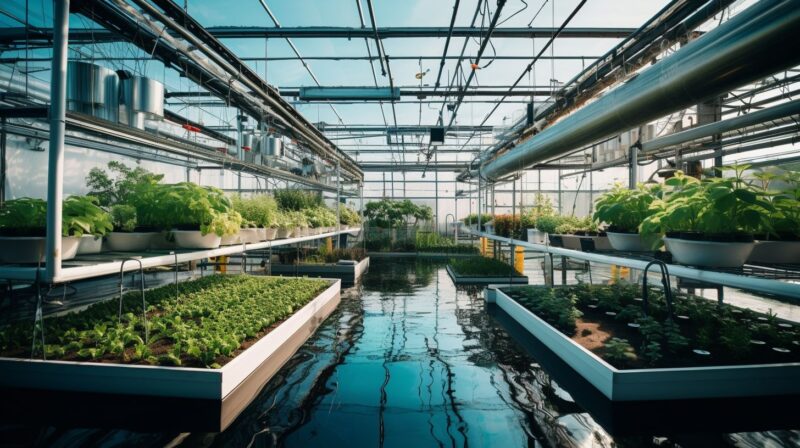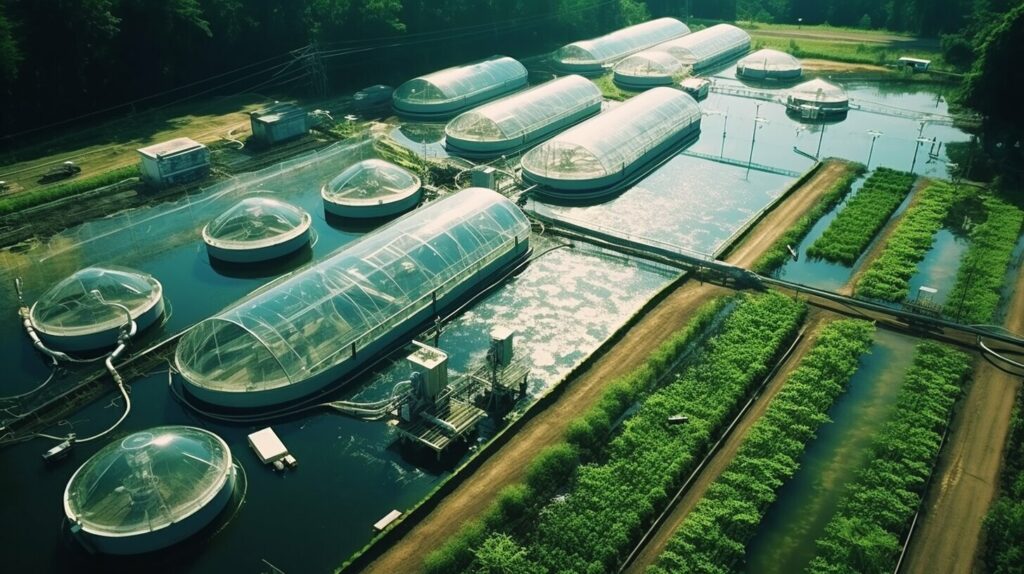This post may contain affiliate links and we may earn a small commission when you click on the links at no additional cost to you. As an Amazon Affiliate, we earn from qualifying purchases. You can read our full disclaimer here.
If you own an aquarium, it’s important to recognize the importance of water parameters like pH, ammonia, nitrites, and nitrates. These factors play a vital role in keeping your aquatic ecosystem healthy and thriving. These water chemistry factors can impact the well-being of your aquatic pets, affecting not just their physical health but also their overall behavior and mood.
It’s important to ensure that the water quality in your fish tank is optimal to support the aquatic life living in it. In this section, we will provide an overview of pH, ammonia, nitrites, and nitrates, their significance in maintaining water quality, and how they affect aquatic ecosystems.
Key Takeaways
- pH, ammonia, nitrites, and nitrates are crucial water parameters that impact the health of aquatic life.
- Maintaining water quality and managing water chemistry factors heavily rely on the nitrogen cycle.
- Regular water testing and appropriate filtration systems are crucial in ensuring optimal water quality for your fish tank.
The Importance of pH in Water
Maintaining a healthy aquatic environment requires monitoring pH levels as it is a crucial factor. pH is a measurement of the acidity or alkalinity of water and it is measured on a scale of 0 to 14, where 7 is considered neutral. If the value is below 7, it indicates acidic water, while values above 7 indicate alkaline or basic water.
The Ideal pH Range for Different Types of Aquatic Environments
It’s important to note that the ideal pH level for your aquarium depends on the type of aquatic environment you’re trying to create. For example:
- Freshwater fish generally require a pH level between 6.5 and 7.5
- Marine fish require a pH level between 8.1 and 8.4
- Corals and invertebrates require a pH level between 8 and 8.4
It is important to maintain appropriate pH levels for the well-being of your aquatic pets. If pH levels become too acidic or too alkaline, it can cause stress, disease, and even death.
The Consequences of pH Imbalances
When pH levels are not within the appropriate range for your aquatic environment, it can have a number of negative consequences. For example:
- Low pH levels can cause stress and respiratory problems for fish, leading to death if left unchecked
- High pH levels can cause alkalosis, which can also be lethal to fish
- Fluctuations in pH can cause stress and weaken the immune system of aquatic pets, leaving them vulnerable to disease and parasites
It is important to keep a close eye on the pH levels of your aquatic pets’ habitat and take necessary steps to ensure they stay within a healthy range for the well-being of your pets. There are a number of methods for adjusting pH levels, including the use of chemical additives, adding alkaline or acidic materials to the water, and adjusting CO2 levels. However, it’s important to do so gradually and carefully, as sudden changes in pH can be just as detrimental to your aquatic pets as sustained imbalances.
Understanding Ammonia in Water
Ammonia is a gas that is colorless and has a strong smell that can be harmful to aquatic creatures. In water, it exists in two forms: ionized ammonium (NH4+) and un-ionized ammonia (NH3). While ammonium is not typically harmful, un-ionized ammonia has the potential to be toxic to aquatic life, including fish.
Ammonia is mainly generated in aquatic environments through the waste products of aquatic animals, such as fish, and the decomposition of uneaten food and other organic matter.
Ammonia plays a crucial role in the nitrogen cycle, which is a natural process that transforms harmful nitrogen waste into safer substances. During the nitrogen cycle, ammonia is first converted into nitrite (NO2-) by nitrifying bacteria. Another group of nitrifying bacteria converts nitrite into nitrate (NO3-).
The Nitrogen Cycle
The nitrogen cycle is essential for preserving the quality of water in your fish tank. An established nitrogen cycle ensures that harmful ammonia is efficiently converted into less harmful nitrate.
| Stage | Description |
|---|---|
| Ammonia | The initial stage of the nitrogen cycle, where ammonia is produced through the breakdown of organic matter and fish waste. |
| Nitrite | Nitrite is formed when ammonia is broken down by nitrosomonas bacteria. Nitrite is also toxic to fish and other aquatic animals. |
| Nitrate | Nitrate is formed when nitrite is broken down by nitrobacter bacteria. Nitrate is far less harmful to fish and other aquatic animals than ammonia or nitrite. |
In an established aquarium, there should be no detectable ammonia or nitrite, and nitrate levels should be kept below 40 ppm (parts per million). High levels of ammonia and nitrite can indicate an incomplete nitrogen cycle or overfeeding and can harm the health of your aquatic pets.
Testing your aquarium water regularly for ammonia, nitrite, and nitrate is essential for maintaining the health of your aquatic pets. While small amounts of ammonia and nitrite can occur naturally in some aquariums, it is crucial to keep these levels as close to 0 ppm as possible.
The Role of Nitrites in Water
As mentioned earlier, nitrites are formed during the nitrogen cycle, which occurs naturally in aquatic ecosystems. Nitrites are toxic to aquatic organisms, and their presence in water can have harmful effects. The process of nitrification, which converts ammonia to nitrite, is performed by beneficial bacteria in the aquarium. However, a buildup of nitrites can occur if the bacteria are unable to keep up with the ammonia production.
Elevated nitrite levels can cause fish to become stressed and susceptible to disease. The symptoms of nitrite poisoning include lethargy, loss of appetite, and abnormal swimming behavior. Severe cases lead to death.

To mitigate potential dangers of elevated nitrite levels, it is important to regularly test your aquarium water and monitor nitrite levels. If your nitrite levels are high, perform a partial water change or add bacteria supplements to help reduce the concentration. You can also increase the frequency of water changes to reduce the nitrite buildup, or adjust the feeding schedule to reduce the amount of waste produced in the aquarium.
Controlling Nitrite Levels for a Healthy Aquarium
To maintain a healthy aquarium, it is important to keep nitrite levels within safe limits. The recommended range of nitrite concentration in an aquarium is less than 0.5 ppm (parts per million). When nitrite levels exceed this range, it is time to take action.
There are several ways to control nitrite levels in your aquarium. To manage nitrite levels in your aquarium, there are various approaches you can take. Among these, establishing a consistent nitrogen cycle in your tank is one of the most efficient methods. This cycle involves the conversion of ammonia to nitrite, and then nitrite to nitrate. The nitrate produced is less harmful than nitrite and can be removed from the water through regular water changes.
In addition to establishing a stable nitrogen cycle, you can also help control nitrite levels by using a quality filtration system. Biological filtration, in which bacteria break down waste and convert it into less harmful compounds, is crucial for reducing nitrite levels in the aquarium. It is also important to avoid overfeeding your fish or introducing too many new fish at once, as this can lead to an increase in ammonia production and nitrite levels.
Regular monitoring of your aquarium’s nitrite levels will alert you to potential problems and allow you to take action before nitrite poisoning occurs. To ensure a thriving environment for your fish and other aquatic pets, you can follow these helpful tips.
Understanding Nitrates in Water
Once ammonia and nitrites have been converted into less toxic forms, the next step in the nitrogen cycle is the production of nitrates. Nitrates are less harmful to aquatic organisms than ammonia and nitrites, but they can still pose a threat in high concentrations.
In natural bodies of water, nitrates are typically kept at safe levels through processes such as denitrification by bacteria and absorption by aquatic plants. However, in an aquarium or fish tank, nitrates can accumulate over time, particularly if regular water changes are not performed.
| Nitrate Level | Potential Risks |
|---|---|
| 0-20 ppm | Safe for most fish and aquatic plants |
| 20-40 ppm | Potential stress on some fish and aquatic plants |
| Above 40 ppm | Dangerous for most fish and aquatic plants, can lead to algae blooms and other water quality issues |
Regular water testing is important for detecting and managing nitrate levels in your aquarium. If nitrate levels are too high, performing a water change can help to reduce them. One way to naturally eliminate nitrates from your aquarium is by adding live plants.
It is also important to monitor feeding habits and consider reducing the amount of food given to aquatic pets if excess waste is contributing to high nitrate levels.
Balancing pH Levels in Your Aquarium
Maintaining the appropriate pH level in your aquarium water is essential for ensuring the good health and wellbeing of your aquatic pets. Most fish and invertebrates require a specific pH range to thrive. It’s essential to maintain a stable pH level in your aquarium to ensure the survival of your fish.
Testing Your Aquarium Water pH
The first step in balancing your aquarium pH is to test the water. You can test your aquarium water pH using commercially available testing kits. These kits are easy to use and will give you an accurate reading of your aquarium water pH level. API’s pH Test Kit is an easy-to-use kit with great value for the number of tests provided.

Adjusting Aquarium Water pH
If your aquarium water pH is outside the recommended range for your aquatic pets, you will need to adjust it. There are several ways to adjust aquarium water pH, including:
| Method | Instructions |
|---|---|
| Adding pH adjusters | You can add commercially available pH adjusters such as pH up or pH down to adjust the pH level. It’s essential to adhere to the instructions carefully when adding these products to your aquarium as overdosing can be harmful to your fish. |
| Adding buffer solutions | Buffer solutions can be added to stabilize the pH level in your aquarium. These solutions help prevent sudden fluctuations in pH levels. |
| Using natural methods | You can use natural methods to adjust the pH level of your aquarium water. For instance, adding driftwood or almond leaves can help lower the pH level while crushed coral or limestone can raise it. |
If you need help raising the pH of your aquarium, check out API’s pH Up.
Monitoring and Maintaining Aquarium Water pH
Once you’ve adjusted your aquarium water pH, it’s essential to monitor and maintain it. Test water regularly to ensure the pH level is stable and within the recommended range for your fish. Sudden fluctuations in pH levels can be harmful to your aquatic pets. It’s also important to avoid overfeeding your fish as uneaten food can cause pH fluctuations.
By regularly testing and adjusting your aquarium water pH, you can provide a healthy environment for your aquatic pets to thrive.
Managing Ammonia Levels in Your Water
As we discussed earlier, ammonia is a key parameter to monitor in your aquarium. Fish can get sick or die if there are high levels of ammonia in their environment. It’s important to keep ammonia levels low to keep them healthy and safe. So, how can you manage ammonia levels in your water to maintain a healthy environment for your aquatic pets?
Establishing and maintaining a stable nitrogen cycle is crucial in managing ammonia levels. This cycle involves converting toxic ammonia into less harmful substances like nitrites and nitrates. Beneficial bacteria play a crucial role in this process, breaking down ammonia into nitrites and then converting nitrites into nitrates, which can be safely removed through water changes.
It’s important to note that establishing a nitrogen cycle can take time, and it may take several weeks for the beneficial bacteria to fully colonize your aquarium. In the meantime, regular water testing is essential to monitor ammonia levels and ensure they don’t reach dangerous concentrations.
There are several ways to reduce excess ammonia levels in your water. A possible solution is to conduct partial water changes by taking out some of the water and replacing it with fresh, dechlorinated water. This can help dilute the ammonia concentration in your aquarium. Another option is to use chemical filtration media designed to remove ammonia from the water. However, it’s important to note that these chemicals require regular replacement to remain effective.
Ultimately, maintaining healthy ammonia levels in your aquarium requires a combination of factors, including establishing a stable nitrogen cycle, regular water testing, and appropriate filtration methods.
Controlling Nitrite Levels for a Healthy Aquarium
If you’re an aquarium owner, you know how crucial it is to maintain proper water quality. Nitrites are a significant factor in water quality, and their levels should be closely monitored. In this section, we will provide you with tips and strategies for maintaining healthy nitrite levels in your aquarium.
Understanding Nitrites in Water
Nitrites are produced during the nitrogen cycle, in which beneficial bacteria convert ammonia into nitrites and then into nitrates. Nitrites are toxic to fish and other aquatic organisms, and high levels can lead to illness or even death. It’s important to keep nitrite levels below 0.5 ppm.
Establishing a Stable Nitrogen Cycle
To control nitrite levels, it’s essential to establish a stable nitrogen cycle in your aquarium. This cycle begins with the breakdown of fish waste into ammonia, which is then converted into nitrites by beneficial bacteria. Finally, nitrites are converted into nitrates, which are less harmful to aquatic life.
To establish a stable nitrogen cycle, it’s important to have a properly sized and maintained biological filter. The filter should contain enough beneficial bacteria to convert ammonia and nitrites into nitrates. It is important to refrain from overfeeding your fish to prevent an increase in ammonia levels and disturbance of the nitrogen cycle.
Reducing Nitrite Levels
If nitrite levels rise above 0.5 ppm, it’s important to take action to reduce them. One effective method is to perform partial water changes, which remove nitrites from the water. It’s recommended to change 25% of the water every week, or more frequently if nitrite levels are high.
Another method for reducing nitrite levels is to add more plants to your aquarium. Plants use nitrates for growth, which can help to reduce nitrite levels in the water. Additionally, it’s important to avoid adding too many fish to your aquarium at once, as this can lead to a spike in ammonia levels and disrupt the nitrogen cycle.
Monitoring Nitrite Levels
Regular monitoring of nitrite levels is crucial for maintaining a healthy aquarium. To measure the nitrite levels in your aquarium water, you can utilize a water testing kit specifically designed for this purpose. It’s recommended to test your water at least once a week, or more frequently if you suspect nitrite levels are high.
By taking steps to establish a stable nitrogen cycle, reducing nitrite levels when necessary, and monitoring nitrite levels regularly, you can maintain a healthy environment for your aquatic pets.

Managing Nitrates for a Thriving Aquatic Environment
Controlling nitrate levels is crucial in maintaining water quality and a healthy aquatic environment. High nitrate levels can have detrimental effects on fish and other aquatic organisms, causing stress, weakened immune systems, and even death.
The recommended nitrate level for a healthy aquarium is below 40 ppm. If nitrate levels exceed this threshold, it is essential to take corrective measures to maintain a healthy aquatic environment.
Regular Water Changes
One of the most effective ways to control nitrate levels is through regular water changes. By replacing a portion of the water in your aquarium with fresh, clean water, you can dilute the concentration of nitrates. Aim to change 20 to 25 percent of the water in your aquarium every two weeks, or more frequently if nitrate levels are high.
Live Plants
Live plants are a natural way to remove nitrates from aquarium water. They absorb nitrates through their roots and convert them into biomass. Consider adding aquatic plants to your tank, such as Java fern, Amazon sword, or Anubias nana, to help control nitrate levels.
Nitrate-Reducing Filters
Nitrate-reducing filters are designed to remove nitrates from aquarium water. These filters function by encouraging the development of bacteria capable of converting nitrates into nitrogen gas, which can be safely released into the atmosphere. Consider investing in a nitrate-reducing filter if nitrate levels in your aquarium are persistently high.
- Regular water changes, adding live plants, and using nitrate-reducing filters are excellent methods for controlling and minimizing nitrates in your aquarium.
- Remember to test your aquarium water regularly to ensure nitrate levels remain within the recommended range for a healthy aquatic environment.
The Impact of Water Chemistry on Aquatic Life
Understanding the importance of water chemistry in maintaining a healthy aquatic environment is crucial for any fish tank owner. The pH level, ammonia, nitrites, and nitrates in water are all linked together, and imbalances in any of these factors can harm aquatic living beings. Let’s delve into the significance of each of these parameters:
pH
The pH scale is used to determine whether water is acidic or alkaline. The ideal pH range for most freshwater fish is between 6.5 and 7.5. Any significant deviations from this range can cause stress to fish and negatively impact their health, behavior, and breeding. High pH levels can lead to mineral buildup and cloudy water, while low pH levels can cause corrosion and harm to fish gills and skin.
Ammonia
In an aquarium, ammonia can be a harmful substance that results from decaying organic matter and fish waste. It is harmful to fish, causing stress, disease, and even death. Establishing a healthy nitrogen cycle is essential to ensure that ammonia is efficiently converted to less toxic compounds such as nitrites and nitrates.
Nitrites
During the second stage of the nitrogen cycle, helpful bacteria convert ammonia into nitrites. Nitrites are a byproduct of this process. Like ammonia, nitrites are toxic to fish and can cause significant damage to their gills. It’s important to maintain low nitrite levels to promote a healthy aquatic environment.
Nitrates
The end result of the nitrogen cycle is nitrates, which are comparatively less harmful than ammonia and nitrites. However, high nitrate concentrations can still lead to health problems in fish, including stress, disease, and reduced growth rates. Regular water changes and the use of natural nitrate removers such as live plants can help maintain healthy nitrate levels in your aquarium.
Ensuring optimal water chemistry in your aquarium is crucial to creating a healthy and thriving environment for your aquatic pets. Regular monitoring, appropriate feeding habits, and the use of quality filtration systems can all help in maintaining optimal water parameters and ensuring the overall health of your fish and plants.
Ensuring Water Quality for Your Aquatic Pets
Keeping your aquatic pets healthy and happy starts with maintaining optimal water quality in their tank. Here are some general tips to ensure that your fish and other aquatic creatures thrive in their environment:
- Monitor your water quality regularly. Conduct water tests at least once a week to check pH, ammonia, nitrite, and nitrate levels.
- Ensure appropriate feeding habits. Overfeeding can lead to excess waste and elevated nutrient levels in your tank.
- Incorporate quality filtration systems. A good filtration system efficiently removes waste and pollutants from the water, keeping it clean and healthy for your pets.
- Change your water regularly. Regular partial water changes can help remove excess nutrients and waste from the tank.
- Consider live plants. Live plants can help absorb excess nutrients and provide oxygen to the tank.
By following these tips and paying close attention to your aquatic pets’ water quality, you can create a thriving environment for them to live in. Remember, healthy water leads to healthy pets!
Conclusion
It’s crucial to recognize the significance of maintaining appropriate water chemistry and quality in your aquarium to ensure the optimal health and well-being of your aquatic pets. pH, ammonia, nitrites, and nitrates are crucial water parameters that can greatly affect the nitrogen cycle and the overall health of your aquatic ecosystem.
To ensure a healthy environment for your fish and other aquatic creatures, it’s important to monitor and make necessary adjustments to these parameters. Regular water testing, appropriate feeding habits, and proper filtration systems can all help ensure that the water in your fish tank remains healthy and balanced.
Remember that maintaining optimal water quality is a continuous process, and it requires some effort and attention on your part. However, the rewards of a thriving and healthy aquatic environment are well worth it. By acquiring some basic knowledge and putting in some effort, you can craft a stunning and healthy living space for your aquatic companions.




Pingback: How to Treat Aquaponics Water without Harming Fish and Plants
Pingback: How to Design Aquaponics System for Small Spaces - Aquaponics Daily